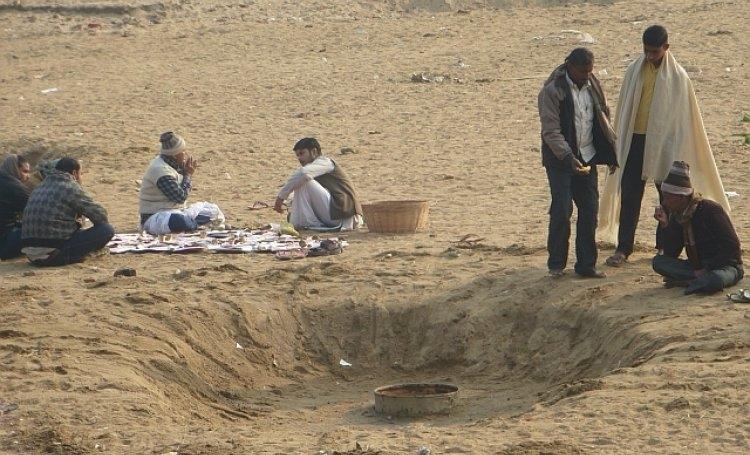Monsoon Delayed, Water Crisis Intensifies in Bihar

Patna: It is no longer an unusual sight ahead of the monsoon in Bihar. As the state continues to reel under a water crisis, women and children can be seen standing in queues for hours, waiting to collect water from tankers or public taps. Faced with acute water scarcity, people of Bihar have been staging protests. There are reports of even clashes between groups over water.
With no pre-monsoon rain in the first week of June, the water crisis has intensified, and is hitting urban as well as the rural areas.
Out of the 534 blocks from 38 districts, 280 blocks from 25 districts were declared drought-hit last year after deficient rainfall.
With most of the water bodies dried up, cattle are struggling for survival. Reports said that a few wild animals like deer too were found roaming outside the villages, seemingly in search of water. Farmers have been forced to sell their livestock as they are failing in arranging water for them.
In Gaya town, hundreds of families have reportedly shifted temporarily to their native villages or other places to cope with the water crisis until arrival of the monsoon.
There is no relief in sight, as the arrival of monsoon is expected to be delayed this year. Every year, the monsoon reaches the Northern state by June 12-13, but as per the latest forecast by the Indian Meteorological Department, the state will witness monsoon showers only after June 21-22, said S K Patil, officer from the Patna Meteorology Department.
“All handpumps have dried up and even submersible pumps have failed in catching water, as the ground water level has depleted like never before in Gewal Bigha locality, in the heart of Gaya. We are managing life with irregular and brief supply of tap water and water from the tankers,” said Dr Roomi, a local resident told NewsClick.
According to district officials, water level of the river Falgu – perceived as the lifeline of the holy town of Gaya – has decreased nearly by 60 feet in the last two years. “Falgu’s water level used to be hardly two-three feet below the ground level. It decreased by 30 feet last year, and by another 30 feet this year. This has forced authorities to shut down pumping stations and water supply centres,” said Manish Kumar, executive engineer, Bihar Urban Infrastructure Development Corporation.
“As against the daily requirement of 60 million litres of water, people are getting nearly five million litres of water daily; it is only 7.6% of their requirement,” a district official told NewsClick.
Surprisingly, people from the water-rich Northern part of Bihar, especially from Darbhanga district, are also facing water scarcity, this summer. People from several localities in Darbhanga are dependent on water supply from tankers, as hand pumps have not been able to fetch water.
The flood-prone Darbhanga and other neighbouring districts of Mithilanchal region are known as a hub of ponds. However, many of them have now either been encroached by powerful people or dried up over the years due to negligence. Following the water crisis in the city, Darbhanga district magistrate Thiyagarajan S M has constituted four separate teams of officials to conduct a survey of the governments soon.
Narayanjee Choudhary, who runs the Talab Bachao Abhiyan, told NewsClick that there were more than 300 ponds in Darbhanga town in the 60s; by 90s, its number came down to 200, and now, it is less than 100.
Water crisis is more or less the same in other districts including Rohtas, Vaishali, Samastipur, Saran, Jehanabad, Kaimur, Bhagalpur and Banka.
Bihar Chief Secretary Deepak Kumar has directed concerned officials from all the districts to undertake replenishment and restoration of ponds, and to remove encroachment around the ponds. Besides, Kumar has recommended rainwater harvesting to deal with the shortage of water.
As per the government’s own admission, 12,027 water bodies including ponds, of total 1.99 lakh water bodies, have been encroached by a nexus of powerful people and others. It was revealed in 2016 after Patna High Court ordered the state government to identify water bodies including ponds, and to take action to free them of the encroachment.
Ranjeev, a water conservation activist, said, “A large part of Bihar is facing acute drinking and irrigation water scarcity. There is no stress on water harvesting despite the fact that the state has been receiving significantly less rainfall compared to the last decade. With ponds disappeared, people are forced to depend on deep and deep bore wells, as ground water depletes. AIIMS Patna was constructed after filling ponds spread over 35 acres. There were nearly 1,000 ponds in Patna, but their numbers have come down to little over 200. Several residential localities have been developed after big ponds were levelled. The government itself has constructed some buildings after filling the ponds.”
Bihar Pollution Control Board Chairman A K Ghosh said that there would be a huge drinking water crisis in Patna by 2030 because the source of ground water recharge has been blocked by concrete. “There is urgent need to save water bodies including ponds, and importance should be given to recharge of ground water,” said Ghosh.
The latest 2016-17 report of the Central Ground Water Board shows that the water level in May 2916, with respect to pre-monsoon decadal mean of May (May 2006 to May 2015) witnessed fall by 67%. Scientists have made it clear that indiscriminate exploitation of underground water from deeper aquifers could create a grim situation in future.
Also read: Drinking Water Crisis in Karnataka Persists, Forces Schools in Udupi to Stall Mid-Day Meal Scheme
Get the latest reports & analysis with people's perspective on Protests, movements & deep analytical videos, discussions of the current affairs in your Telegram app. Subscribe to NewsClick's Telegram channel & get Real-Time updates on stories, as they get published on our website.
























